Icy Inverts Cruise 2013 - Shipboard Blog - Jan 6th to Jan 9th
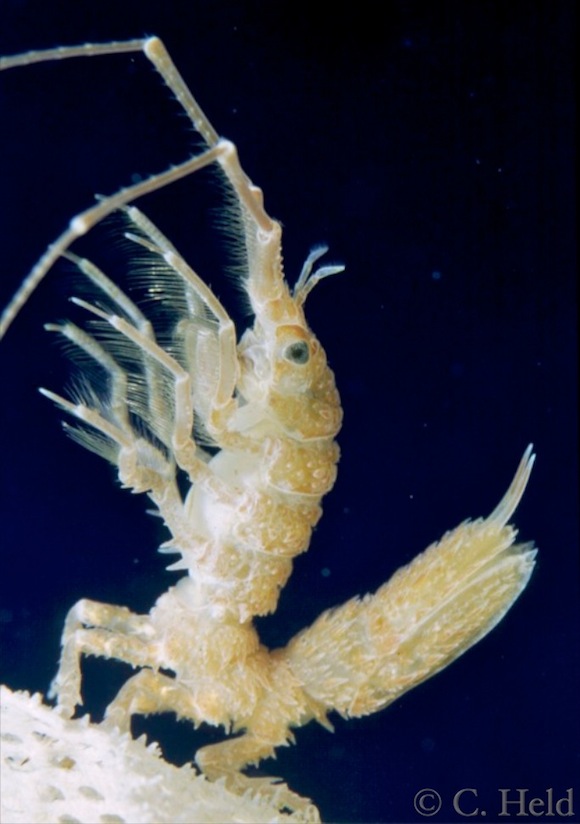
Above picture: An Antarctic isopod from the genus Antarcturus, one of Dr. Held's favorite invertebrates.
09 Jan 2013: Drake Passage (53° 32.2`S, 75° 24.6`W)
I cannot think of a better way to introduce myself than saying that as I am typing this we are just passing by my house. To be more precise, we have passed 53° 32.1516' latitude, only we are in the Southern hemisphere, not up in Northern Germany where I am head of the Molecular Evolution Lab at the Alfred Wegener Institute. Although moaning about the weather that was so much better when whoever is talking was young has become part of our cultural identity, it is hard to deny that it is a lot colder down here than summers in my hometown. Passing by this latitude for the third time in two weeks we are approaching statistical significance on this statement. This is a friendly reminder that local climate is not just dependent on solar irradiation, which is determined by latitude, but that ocean currents are very important, too. Europe is a lot warmer than it otherwise would be thanks to the warm Gulf stream, in turn the same position on the Southern hemisphere where, i.e. where we are now, is strongly influenced by colder currents. The Southern Ocean does not receive any warm surface waters from lower latitudes due to the Antarctic Circumpolar Current (ACC), which is making it so cold.
On our journey towards the South we are accompanied by birds. Leaving the coastal waters behind, the bird fauna changes from typical coastal birds like terns and shags towards true open water species, most noticeably the albatrosses. Right now we are accompanied by one of the birds with the largest wingspan alive, a Royal albatross (below picture). Despite its enormous wingspan of more than 3 meters these majestic birds seem unaffected by the strongest of winds. It is unclear how many species of Royal and Wandering albatrosses there are, some plumages are remarkably hard to tell apart and some species cannot be identified without the help of molecular genetic studies.
Working with benthic invertebrates myself, this is pretty much the situation we are facing ourselves and one of the reasons I am grateful to have been invited to this expedition. Many polar marine species that were previously believed to occur all around Antarctica turned out to be collections of morphologically similar but genetically isolated species. One of my interests is to find out why that is and what has been driving the formation of species in this fascinating cold-water environment. The Southern Ocean is perhaps the least well known continental marine ecosystem and the region we are targeting, Bellingshausen and Amundsen Seas, are literally white spots on the map to this day, which is why we are very excited to see what is there and how it fits into samples from the Antarctic Peninsula, the Weddell Sea and the Ross Sea. Should we come across some of my target species, you will hear me scream with excitement, I promise.
Contributed by: Dr. Christoph Held, Alfred Wegener Institute for Polar and Marine Research (Bremerhaven, Germany)
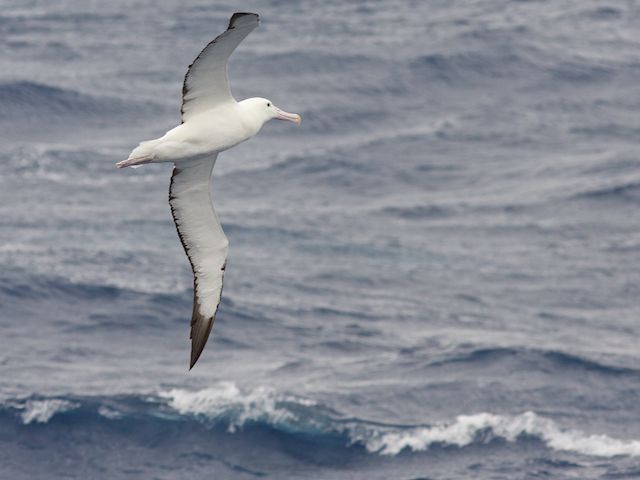
***************************************************************************************
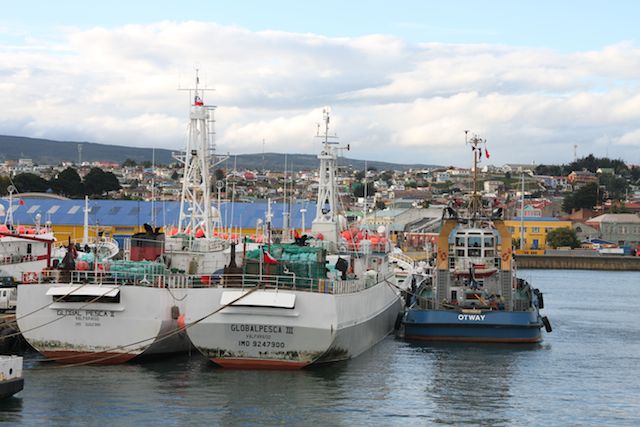
08 Jan 2013: Punta Arenas, Chile (53o 13.3`S, 70o 50.1`W)
When the Nathaniel B. Palmer took off from Punta Arenas on New Year’s Day, I hoped I would make it back to Chile some day. I just didn’t expect it to be so soon (above picture). Yesterday evening we docked, went through customs, and re-entered Chile. While the medical issue was being attended to (side note: all persons are OK), most of the science party took the opportunity to get off the ship and see a little more of Punta Arenas. Everyone had their own shopping list or agenda during our time on land. Shopping lists included a diversity of items such as a cheap digital watch, shampoo, and candy (not like there is a shortage of good food and snacks on the ship!). Also, because the Palmer is a dry ship, a stop by Santino’s for a respite was most welcome.
Now, we’re back to business and on our way to our first sampling site. I’m a finishing up Ph.D. student in Ken Halanych’s lab at Auburn University. I’ve been on four research cruises before and loved each experience. That’s why I was ecstatic to participate in this cruise. However, almost exactly one month after I get back to Auburn, I’ll be defending my Ph.D. dissertation. That means that I’ve been taking advantage of the time in transit by hiding in my room finishing up the writing for my dissertation. Like a lot of scientists on board, my research deals with studying the evolutionary relationships among different groups of animals. For my dissertation, I’ve been looking at how different groups of molluscs (snails, slugs, clams, squid, etc.) are related. To do this, we compare genetic (i.e., DNA) sequences from representatives of different species to reconstruct their “family tree.” In practice, this generally means that we get a tissue sample from an organism of interest, homogenize it (grind it up) to extract RNA (RNA is used to make the proteins expressed in the cell), and process that so it can be sequenced using some of the latest sequencing technologies. Finally, the data is analyzed using computers.
One of the groups of animals I’m especially interested in is the aplacophoran molluscs. Never heard of them? You’re not alone. The name aplacophoran roughly means “without a shell.” Although these unusual, shell-less, worm-shaped molluscs (below picture) are a somewhat obscure group of mostly deep-sea invertebrates, they are thought to be important to understanding the fossil record, especially certain fossils thought to be early molluscs. In addition to doing molecular- and computer-based work, I’m interested in studying the anatomy and taxonomy (naming and describing new species) of this group. I’m currently working with an expert in Norway to name and describe three new species that I discovered last year. Notably, I found them virtually right off the dock of a major marine laboratory with a long history of studying invertebrates! How many do you think we’ll find in the remote Ross Sea of Antarctica?
Contributed by: Kevin Kocot, Ph.D. Candidate, Auburn University
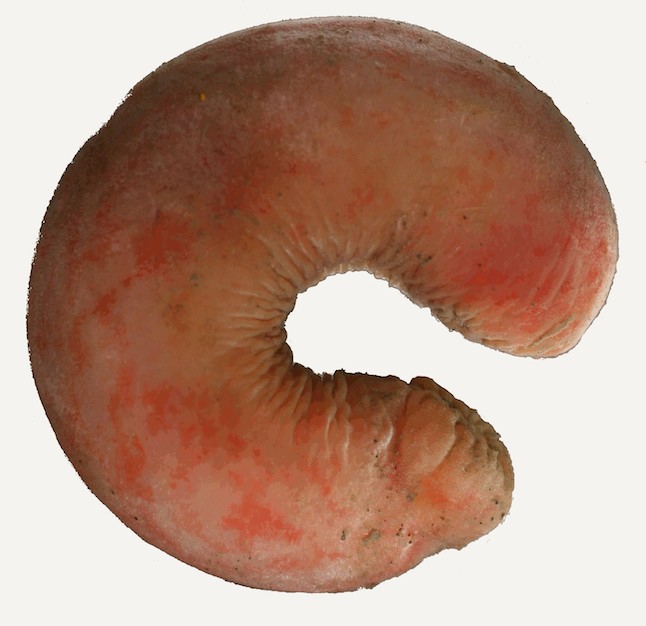
***************************************************************************************
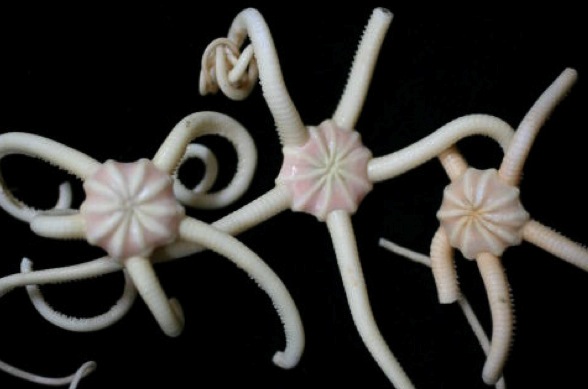
Above picture: The Antarctic brittle star Astrotoma agassizii sampled on a previous cruise.
07 Jan 2013: Straits of Magellan (53o 46.6`S, 71o 50.2`W)
One of the major international concerns among scientist over the past several years is the growing impact of man on the natural balance of gases in the atmosphere. In addition to climate change, one of the main concerns with increased carbon dioxide is ocean acidification. The amount of carbon dioxide in the air directly relates to the acidity of our oceans. Importantly, how vulnerable marine creatures are to the impacts of ocean acidification is not clear.
Coming from the McClintock Lab at the University of Alabama Birmingham (UAB), my goal mainly deals with echinoderm (sea stars, urchins, etc.) sensitivity to ocean acidification. My work on the ship will focus on elemental composition of Echinoderm skeletons. I will also be collecting other invertebrates when possible and looking at the composition of their shells/skeletons. I have put a focus on echinoderms primarily because of the crucial role they play in the global carbon cycle. A second reason to focus on echinoderms is that their skeleton is comprised of magnesium calcite. This mineral element is the most vulnerable to dissolution in increasingly acidic waters. By determining elemental composition of echinoderm skeletons, we are able to establish a baseline of magnesium calcite levels in Antarctic echinoderm skeletons. From there, we can determine species that are more susceptible to dissolution and, therefore, more threatened by ocean acidification. Because of our sampling regime, I will be able to compare skeletal composition of echinoderms over both small and large geographic scales.
I am also hoping to use animals such as sea urchins with discrete body components to compare magnesium calcite levels between body parts. Urchins, for example, can be divided into spines, teste (skeletal body), and their feeding apparatus (Aristotle’s lantern). If, for example, the spines have the highest level of magnesium calcite compared to the lantern and the teste, then they will be more susceptible to dissolution in acidic waters. For the urchin, this means that it will lose its defense before anything else.
That is only one portion of the work taking place aboard the ship. Stay tuned for more of the science. Thank you to family, friends, and colleagues for following us as we undertake such a unique adventure.
Contributed by: Ashley Duquette, Ph.D. Candidate, University of Alabama, Birmingham
Below picture: An Antarctic asteroid (sea star) sampled on a previous cruise.
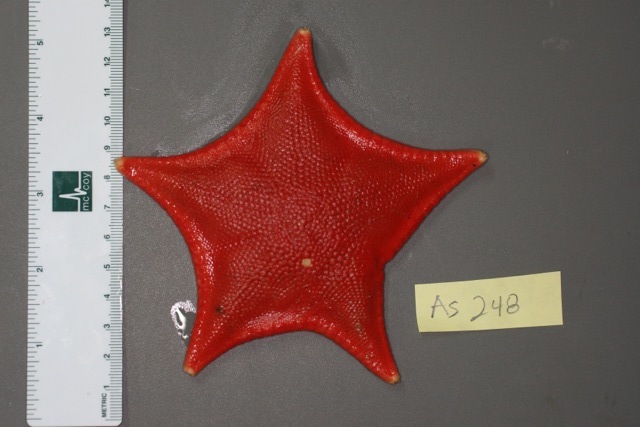
***************************************************************************************

Above picture: An Antarctic bryozoan sampled on a previous cruise.
06 Jan 2013: Southwest of South America (55o 08.2`S, 77o 08.4`W)
"Why should you care about the biodiversity of Antarctica?"
Biodiversity's intrinsic value to society can sometimes be difficult to quantify, especially when faced with questions such as "So what if there is one less species of clam, weed, insect, or bat on the planet? What good are they to me?" As scientists primarily interested in the diverse forms and evolutionary relationships among animals (backboned or not), we sometimes forget that there are many people that do not share our enthusiasm for biological diversity. Clearly there is more general support for preserving species that are identified as charismatic macrofauna (big cute animals) such as tigers, whales, and penguins, but to some degree the acknowledgment of their value is based on their perceived attractiveness. Let me qualify my previous statement by noting that all of us on this research cruise get excited by all sorts of beautiful animals (and we have the photos to prove it), however each of us has dedicated their careers to the study and preservation of animal species of which most people have never heard. We spend our time painstakingly sorting though plankton and dredged bottom samples under the microscope hoping to find the larval or adult form of a new species of marine invertebrate. Our dinner conversations are laden with scientific jargon about colonial bryozoans, interstitial aplacophorans, tentaculate pterobranchs, predatory nemertean worms, and giant pycnogonids (sea spiders). So focused can our attentions be that personality comparisons to the character "Sheldon" on the television show The Big Bang Theory are not too far off from the truth (but several of us are bigger fans of Doctor Who).
Since all of the invertebrate types I mention occur in marine habitats throughout the world, why then are we traveling to the ends of the Earth to study them in Antarctica? Simply put, the marine invertebrate communities found on the Antarctic shelf are utterly fantastic, filled with amazing species not found anywhere else on the planet. To some degree, Antarctic marine invertebrate communities appear more similar to those of the Paleozoic Era, when bryozoans, brachiopods, and sponges built large reefs as opposed to the coral-dominated reefs we are more familiar with today. Therefore, Antarctic marine environments provide key insights into our planet's biological past, and also the realization that the Antarctic's fragile biodiversity is threatened by global environmental change and ocean acidification. It is quite possible that our research cruise will document several new species of invertebrate that will be extinct in the not too distant future. If you are not yet convinced of the intrinsic value of Antarctic's biodiversity, then I will provide you with one last example. Some of the more promising anticancer drugs currently being tested are called Bryostatins, these compounds are produced by a bryozoan called Bugula neritina as a chemical deterrent against predation. No one could have predicted that the study of a small colonial invertebrate would lead to a prominent cancer treatment, but other examples similar to this one are being regularly discovered from invertebrates found worldwide, including species from Antarctica. What other beneficial features will be found through the study of Antarctic biodiversity? This question can only be answered by more intensive sampling, and since we have only scratched the surface of Antarctica's biological wealth, it follows that we should do everything we can to document and preserve the marine communities surrounding this unique continent before they are irrevocably changed due to anthropogenic (human-mediated) impacts.
Contributed by: Dr. Scott Santagata, Assistant Professor of Biology, Long Island University-Post
Below picture: Underwater video still from a previous cruise, featuring a seasquirt (middle) and bryozoan (left).
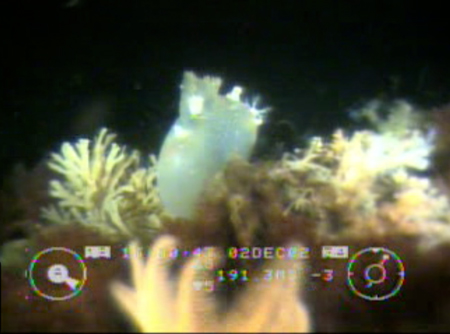
Last updated: 11/12/2013
